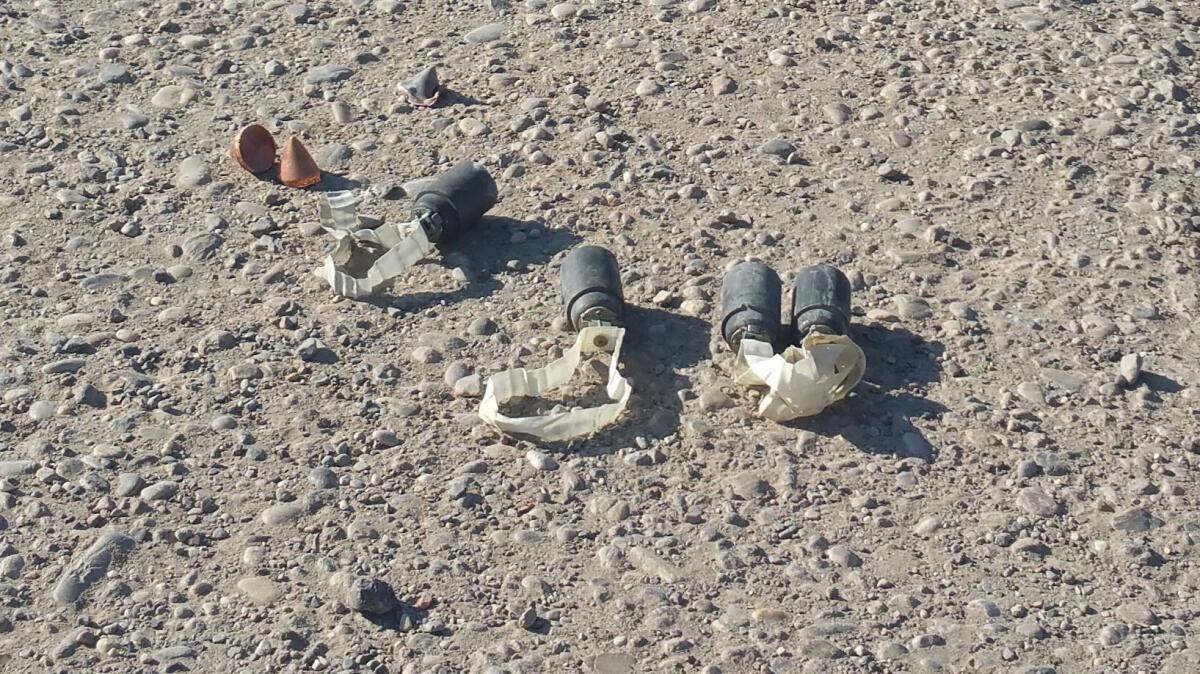Islamic State fires cluster bombs at Iraqi government forces

Cluster bombs struck an operational headquarters for Iraqi troops in the village of Areyj, near Mosul.
- Share via
Reporting from Areyj, Iraq — Islamic State extremists fired cluster bombs at Iraqi government forces stationed near the northern Iraqi city of Mosul on Tuesday, killing at least one soldier.
The attack, which came on the third day of a large-scale government offensive to take back west Mosul, marks one of the few instances the militants have used this type of ordnance, which is banned under the 2008 Convention on Cluster Munitions.
Cluster bombs struck an operational headquarters for Iraqi troops in the village of Areyj, near Mosul. A number of U.S. soldiers with the coalition are also bunkered there in a separate area of the compound.
Damien Spleeters, the head of Iraq operations for Conflict Armament Research, a group which identifies and tracks weapons used in armed conflicts, said the use of cluster munitions by Islamic State is “a very, very rare occurrence.” Similar bombs were used by the extremist group in the Syrian border town of Kobani in 2014, he said.
“This is only the second or third time I see it used by ISIS,” Spleeters said in an interview. Islamic State is also known as ISIS or ISIL.

The first sign of the attack Tuesday was a loud explosion followed by a series of what sounded like fireworks for more than five seconds. Troops who were not injured ran toward the explosions, scanning the sky for Islamic State drones. One Iraqi soldier could be heard screaming in pain. Others rushed to his side, and carried him toward a waiting bus.
“Where’s the ambulance? Ambulance!” he screamed. He was joined by another soldier, his left hand reduced to a shredded mess.
One soldier was killed instantly when a set of bomblets landed beside the blue federal police pickup truck where he was sitting, peppering it with shrapnel.
In the immediate aftermath of the attack, military commanders scrambled two helicopters to hunt for what they thought were Islamic State drones with weapons, while those on the ground nervously scanned the sky and fired their machine guns.
Mosul, which is bisected by the Tigris River, was seized by Islamic State militants in the summer of 2014. The group took much of the oil-rich desert region between Iraq and Syria.
In June, the group was seen in a video celebrating a victory over the U.S. trained rebel New Syrian Army in a fight for territory near the Syrian border town of Bukamal. Islamic State fighters rode in trucks marked with the New Syrian Army insignia and were seen with heavy weapons and ammunition apparently captured in the fighting.
Islamic State has in recent months ramped up the use of commercially available drones that it then modifies to deliver a payload of up to three hand grenades. In the eastern half of Mosul, which Iraqi officials said was taken back from the jihadists in January, the attacks have become an almost daily occurrence, causing panic whenever their characteristic buzz can be heard.
U.S. servicemen, who quickly placed bright fluorescent ribbons to mark unexploded bomblets, said the ordnance appeared to have been delivered via a rocket. They had retrieved a base plate for later analysis.
They also speculated that any drones used in the assault would have been for surveillance purposes and did not drop the bombs.
Lt. Gen. Stephen Townsend, commander of U.S. forces in Iraq and Syria, has said that in recent weeks about 450 U.S. special forces and spotters have traveled with Iraqis to direct airstrikes against Islamic State and advise commanders.
The attack Tuesday coincided with a news conference by Iraqi military officials announcing the end of the first phase of operations for the Mosul offensive, which has brought troops to the southern edge of the city.
On Monday, the federal police and its special forces arm, the emergency response division, had overrun the village of Albu Sayf, situated on a hilltop overlooking Mosul’s airport.
Charred vehicles littered the newly opened road to Albu Sayf, where a number of the militants’ corpses had been left to be eaten by stray dogs as security forces established a defensive berm on the village’s edge.
Bulos is a special correspondent.
More to Read
Sign up for Essential California
The most important California stories and recommendations in your inbox every morning.
You may occasionally receive promotional content from the Los Angeles Times.











